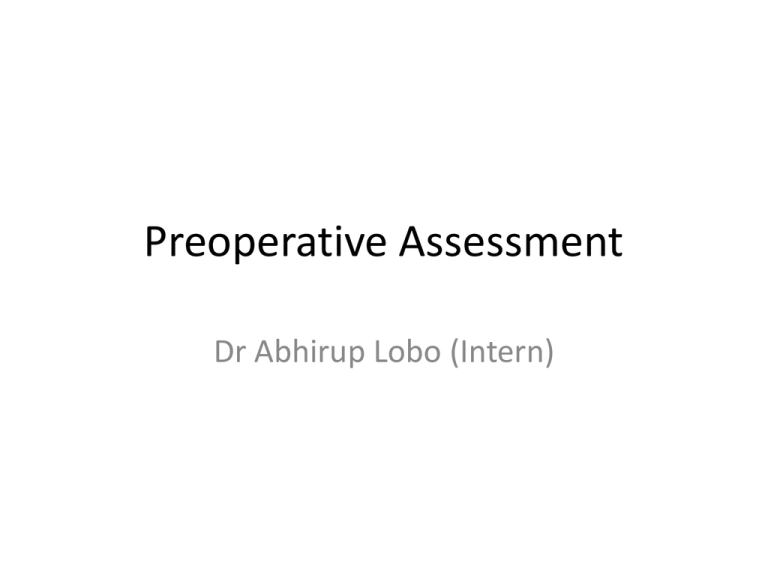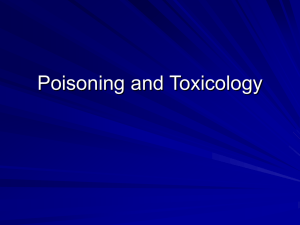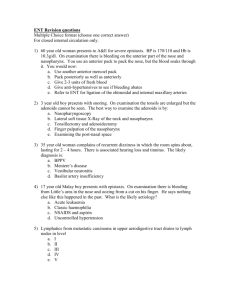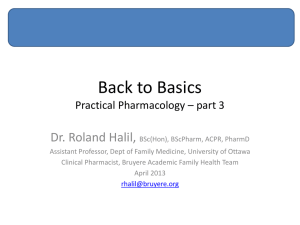
Preoperative Assessment
Dr Abhirup Lobo (Intern)
Preoperative assessment
-
Assess patient’s health
Anticipate problems
Informed consent
Education
Goal???
To reduce a patient’s morbidity and mortality
By-product?
Reduces unnecessary cancellations
HOPC
• What’s the problem?
– Is it acute or chronic?
• What are the symptoms?
– Local vs. systemic
• Why is the patient having this operation?
• Why now?
Past surgical history
Includes past anaesthetic history
• Reactions to anaesthetic
– PONV
– Difficult airways/IV
– Rare: Malignant hyperthermia
• Post surgical complications
Past medical history – by system
• Cardiovascular (IHD inc angina, HF, AF,
strokes/TIAs)
• Respiratory (COPD, asthma, past/current PE)
• Haematology (anaemia, bruising/bleeding)
• Renal (renal failure/disease)
• Liver (Hep B/C, IVDU, past jaundice)
• Endocrine (Diabetes – hypo/hyperglycemia, BSLs,
complications – renal, eye, foot)
• Arthritis
Family history
• Reactions to anaesthetic:
– Malignant hyperthermia
Medications
Continue:
• Antihypertensives
• Beta-blockers
• Statins
Consider:
• Anticoagulants inc aspirin, warfarin, clopidogrel
• Diabetic meds: insulin, oral hypoglycemics
• Other medications of concern:
– Steroids
– OCP
Medications (cont’d)
Allergies
Analgesia - NSAIDs
Social history
•
•
•
•
•
•
Premorbid function inc ADLs
Occupation
Social supports
Smoking
Alcohol
Drugs + tolerance to opioids
Examination
• Vitals
• Airway assessment
– Done by the anaesthetist in PAC
– dentition
– neck mobility
– sex
– Obesity
– Beard!!
– Mallampati score (score ≥ III)
– Thyromental distance (unreliable)
Mallampati score
What’s the ASA?
• ASA I Healthy patient
• ASA II Mild systemic disease with no functional limitation for example, controlled hypertension
• ASA III Severe systemic disease with definite functional
limitation - for example, chronic obstructive pulmonary
disease
• ASA IV Severe systemic disease that is a constant threat to
life - for example, unstable angina
• ASA V Moribund patient who is not expected to survive for
24 hours with or without surgery - for example, with an
abdominal aortic aneurysm
Suffix E Emergency procedure
Focussed examination
• Cardiovascular
• Respiratory
Consider:
• Abdominal exam
• Neurological exam
• Joint exam
• Vascular exam
Investigations
• Bloods
• Imaging
• Other
How much should you test?
Group and Save
X-match
X-match
X-match
Need for
transfusion
Unlikely
Likely
Definite
Definite
Expected blood
loss
<1L
<2L
<3L
>3L
Procedures
Appendicectomy
ERCP
Mastectomy
Gastrostomy
Ileostomy
Cholecystectomy
Thyroidectomy
Minor amputation
Colectomy
Fem pop repair
Laparotomy
TURP
Gastrectomy
Nephrectomy
Abdominoperineal
resection
Cystectomy
AAA repair
(elective)
Aorto-bifemoral
repair
The end of the consult
• So what happens at the end of the consult?
– Check for informed consent (inc form)
– Instructions before the operation
– Information about the surgery, recovery and likely
return to full activity
Case example 1
• 20yo male with no past medical history
• Presents for removal of lipoma
• Famhx: an aunt died due to an “anaesthetic
reaction”
Case example 2
• 70yo female presents for total hip
replacement
• PMHx: AF, TIAs
• Medication: Warfarin
Case example 3
• 65yo male presents for elective TURP
• PMHx: IHD, CABGx2, COPD
• Smoking: 40 pk year hx
Post-op complications
Dr Abhirup Lobo (Intern)
Case 1
55yo female presents with fever of 38.0⁰C postTHR. She has no relevant past medical history.
On examination,
- Vitals: PR80 reg, BP145/80, RR20, Sats 95% RA
- Resp exam: bibasal crackles
What’s the cause of her fever?
Fevers, <24h
- Atelectasis
- Response to surgical trauma
- Necrotising wound infections – much less
likely.
Case example 2
74yo male presents with fever of 38.4⁰C postcholecystectomy. He has no relevant past medical
history.
On examination,
- Vitals: PR95 reg, BP135/80 RR20, Sats 92% RA
Without further examination. What is your
differential diagnosis?
What investigations will you order?
Fevers 24h-72h
• Pulmonary causes eg. atelectasis, pneumonia
inc aspiration
• Catheters!!
– UTI related to foley catheter
– Thromboplebitis from IV cannula
Case example 3
You are the doctor on call overnight. You get
paged about “Mr Hyatts”. The page reads:
“42yo male. 6d post op (L femur # ORIF). Temp is
now 38.0 ⁰C and pt is tachycardic – not
responding to fluids.”
What is your differential diagnosis?
Fever >72h
- DVT!!!
- Infection
- Wound
- UTI
- Pulmonary
5 W’s
- Wind
- Water
- Wound
- Walking
- Wonder drugs
Case example 4
60 yo male presents d5 post laparotomy with
urine output of 20mL/hour. He has been
ambulating. His catheter was removed earlier in
the day.
What do you have to think about?
- Hx
- Ex
- Fluid balance
- Pre-renal vs. Obstruction
Mx:
- Does the pt need rehydration?
- Does the pt need a catheter?
Case example 5
42 yo female presents with SOB 5 hours postpartial thryoidectomy.
PHx: childhood asthma
Meds: Pravastatin
Smoking: 0.5pk/d for 20y
What are your differentials?
Case example 5 cont’d
On examination, the pt is in respiratory distress
and is using her accessory muscles of
respiration. From the end of the bed, you can
hear a loud harsh sound whenever she tries to
take a breath.
PR 110 reg, BP 150/80, RR24, T36.5, Sats 91% RA
Her wound is dressed.
CVR exam: NAD
Case example 5
What’s your differential diagnosis?
Is this an emergency?
What are you going to do?
Case example 6
The nurse on 3SW pages you urgently regarding
a 20yo male 3d post appendicectomy with a red,
purulent wound.
What predisposes you to a wound infection?
Predisposing factors
• Type of surgery
• Pt characteristics












